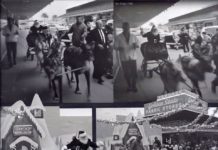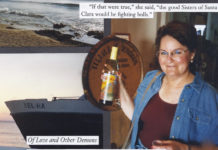
Optimism on New Year’s Eve is a time-honored tradition. Optimism and opportunity are vital elements of our American dream and folklore.
Martin Ridge was my history professor at San Diego State College. In 1949, Ridge and Ray Billington wrote Westward Expansion. The authors “set a new standard for scholarship in western American history” and were acknowledged as the most prominent experts on the frontier era.
They noted, “Economic success was the ordained lot of frontier settlers; men and women had only to apply themselves to achieve wealth and an elevated social status …”
In correspondence, Dr. Ridge wrote, “Americans have a blind eye for hard truths and a clear one for great expectations.”
It has become popular to rewrite history in the new millennium, but there was a time when Americans believed success could be found beyond the next hill.
… And sixty years ago, optimism was high on a hill called Clairemont.
In November 1954, developers Irvin Kahn, Lou Burgener, Carlos Tavares and PCL Padres owner Bill Starr opened the Clairemont Quad (Village) shopping center. “San Diego’s Great New City of Stores” began with 18 businesses and expansion on the drafting boards before the ribbon was even cut.
Local grocery stores advertised bread for 23¢ a loaf. Bologna was 39¢ a pound, a one pound can of coffee cost 89¢, rutabagas were 6¢ a pound and lobster only 69¢ a pound. Texas Liquor Store at the Quad offered “A case of good judgment,” premium Edelweiss beer from Chicago for only $2.95.
A 21” black and white Philco swivel console television set could be purchased for $179. The customer also received S&H Green Stamps.
The first street sweeper was welcomed into our neighborhood on New Year’s Eve 1954. 6,400 new phones had been activated in December. Previously, old-timers remember long lines to talk on Clairemont pay phones.
The state legislature debated whether to increase the maximum speed limit from 55 to 65 mph and Highway Patrol Commissioner B.R. Caldwell argued that California drivers “lack the skill” to drive 65 mph.
“You Can Beat The Atomic Bomb” received mixed reception from Clairemont school children, women’s groups and men’s service clubs. Some were terrified; others found dark humor in the film’s stilted dialog and hackneyed acting.
Extension of Balboa Avenue from the Santa Fe bridge east to Clairemont Drive would begin in 1955.
Donald Leon Unger, Clairemont’s first baby of the new year, received a wide variety of gifts from local merchants. His proud father, Harry Unger, was a sailor stationed at the Naval Training Center. Typical of the times, the infant’s mother was simply identified as Mrs. Harry Unger.
The Clairemont Canary Club was founded in January 1955. It must have been a large club, because the organization had a president, first vice president, second vice president, third vice president, secretary, assistant secretary, but only one treasurer. Anyone with knowledge of the Clairemont Canary Club is asked to contact the Clairemont Times.
On April 9, 1955, over 1,000 Clairemont first and second graders were among the first children nationwide to receive Salk polio inoculations.
Later that summer, an Olympic size swimming pool would open for the residents of the Buena Vista Apartments.
Burgers were 19¢ at King’s Drive-In.
There were, indeed, good reasons for the denizens of Clairemont to be optimistic in 1955.



